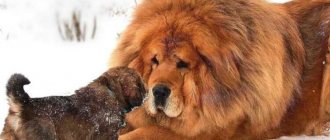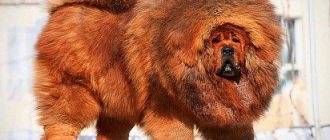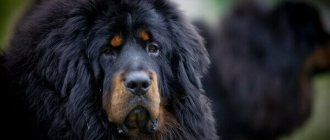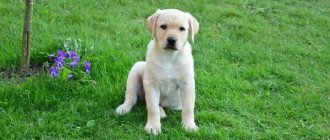Mastiffs are a large group of breeds that include French, English, Major and other dogs with similar traits.
The Tibetan Mastiff stands out especially among them.
This is a breed that not every beginner can handle.
They are difficult to train, but despite their menacing appearance, they are very calm and reasonable dogs.
If you manage to control such a dog, show that you deserve the respect of such a giant, then it will never betray you and will do everything to protect your family.
What does a puppy look like in the photo at 4 months old?
At 4 months, a Tibetan Mastiff puppy already looks quite scary.
His height is 43-48 cm, and his weight is 20-33 kg . That is, he has already reached the size of an average adult dog. Internally, he is still a puppy who needs control and education.
At this age, puppies also begin their active growth phase. At 4 months the dog looks like a smaller copy of an adult dog. The proportions are maintained, but sometimes you can notice that one of the body parts is larger than the rest. This disproportion will disappear with age.
At 4 months, the color may already be determined, but this does not mean that it will remain that way throughout the dog’s entire life . It also happens that over time the color of the Tibetan Mastiff's coat may change.
In other breeds, puberty may already begin at 4 months. This is not the case with Tibetan Mastiffs.
They mature for a long time, up to 3-4 years.
Tibetan mastiff with a person. Interesting Facts
The Tibetans believed that the souls of monks who were not good enough to become human in a new incarnation or reach Shambhala were reborn into Tibetan mastiffs. This is how the Tibetans explained the exceptional intelligence and restraint of these dogs.
Tibetan Mastiff with his owner. Complete peace of mind.
According to legends, Buddha and Genghis Khan are among the owners of Tibetan mastiffs. In Tibet - the homeland of these dogs and in China, the Tibetan mastiff is still revered as sacred.
One Tibetan Mastiff weighs as much as twenty-five large Chihuahuas.
The owners of these dogs note that Tibetan mastiffs living in the house are “silent”, while backyard Tibetans, on the contrary, are capable of stunning with thunderous barking.
The Tibetan Mastiff looks menacing.
A sweater can be knitted from the hair shed by an adult mastiff during the molting period.
Do you like the Tibetan Mastiff? Are you ready to get this breed? Share your opinion with us.
What should I be able to do?
At 4 months, a Tibetan Mastiff puppy is already beginning to show character.
Since this breed needs to be raised and trained from an early age, at this age the dog should already be able to:
- Walk with a collar and leash;
- Know your nickname and the voice of the owner;
- Go to the toilet outside;
- Eat 3-4 times a day;
- Demonstrate your first guard skills;
- Know what “cannot” and “can” mean;
- If you don’t strictly follow commands, then listen to the owner and try to do what he asks.
By this age, it is already important to form an idea of \u200b\u200bfriends and strangers.
Dog character
At this age, you still have a child who needs your love and guidance.
Tibetan Mastiffs are difficult to train, so it is important to be firm and decisive, but not rude . You can’t hit the dog, just shout at it, and in the worst case, shake it by the withers, as mother dogs do in nature.
At this age, you begin to lay in the dog’s mind all the basics that will be useful to it in the future: who is the owner, who is “their own,” what can be done, what cannot be done, nickname, etc.
At 4 months, Tibetan Mastiff puppies will be spoiled, perhaps even disobedient at times . They will be attracted to the games, not what you are trying to give him.
It is important to alternate the process of education and training with rest, because the puppy will quickly get tired if you torment him with commands without a break.
At the same age, the mastiff's guard instinct awakens . This must also be used and directed in the right direction.
Contents of the Tibetan Mastiff
Dry and cool climates are best suited for keeping the Tibetan Mastiff. Due to their thick and dense coat, Tibetans do not tolerate hot, humid climatic conditions well. In hot weather, your pet should be provided with a cool room.
If the dog will live on the street, it is necessary to build an enclosure and a spacious dry kennel. Keeping it on a chain is not recommended; the Tibetan Mastiff is smart and balanced enough not to rush at incoming guests if the owner makes it clear that these guests are welcome.
This dog can live in an apartment. However, remember that this breed is famous for its powerful jaws, inquisitive mind and legendary love for wood of all types. A bored puppy will try anything he can get his hands on. Also provide a place for your pet, taking into account its size and consider washing its paws and bathing. Washing a dog of this size in a standard city apartment bathroom may simply not be feasible.
Prospective owners should understand that the Tibetan Mastiff is the largest dog breed in the world. He will not be able to feel comfortable in a small apartment. These animals need space and freedom.
The Tibetan Mastiff needs constant physical exercise.
Dogs need daily physical activity, for this dog you need to walk for 40 - 50 minutes in the morning and evening, or let him frolic in the yard for the same time. When walking, you should not stick to one route. Firstly, your pet will quickly get bored and will soon stop enjoying the walk. Secondly, a change of place and environment will allow the mastiff to understand that he does not own the whole world, and will make the animal more tolerant towards others.
Due to its independent and stubborn nature, the Tibetan Mastiff is difficult to train, especially if it does not recognize the dominance of its owner. When raising an animal and training it, show tact and patience. Avoid harsh words and actions, otherwise the puppy will grow into a serious problem that will not be easy to deal with.
It can take about two years to fully train a Tibetan Mastiff. If you do not have enough time and experience, it is better to turn to specialists. They will teach your dog basic commands and share effective tips for raising this furry giant.
The Tibetan Mastiff is difficult to train.
Which is better: natural or dry food?
First of all, you need to know that at first you need to feed the puppy what the breeder gave him.
In the future, the choice of food is up to you, but both natural and artificial food have their own disadvantages and advantages:
- Natural food contains natural vitamins and minerals. You will know exactly what you are feeding your pet. But such cooking requires a lot of time, moreover, you must create a properly and balanced menu so that the dog receives all the necessary nutrients.
- Artificial food immediately contains all the vitamins necessary for a dog’s health; no additives are needed. Another thing is that you cannot be sure whether the composition on the package matches the contents. Also, the use of industrial feed is not time-consuming.
Thus, the owner must choose for himself which food is optimal for his dog, weighing all the pros and cons.
Owners of Tibetan Mastiffs
most often use natural dog food .
Expert opinion
Kozhevin Semyon Kirillovich
Expert dog handler.
“Our nursery has always used only natural food for this breed. It’s hard to imagine feeding Tibetan mastiffs artificially. This breed requires a careful and individual approach; you cannot buy such an “approach” in a store. Some puppies need more food, some less, plus vitamins, because raising such a breed is not at all easy. Keeping a mastiff for fun will not work, nor will feeding it store-bought food.”
Keeping a dog at home
The breed requires special conditions. To maintain immunity, your pet’s diet must be balanced and include all the necessary vitamins and microelements. It is prohibited to add natural food to dry food. The diet should be filled with cereals, herbs, vegetables and lean meat. The breed requires physical activity up to 2 hours a day, regular grooming and constant communication.
The pride of the mastiff is its cover, which needs care. This will require a lot of effort from the owners. During shedding, the fur is combed three times a day using special brushes. If the dog lives in an apartment, its fur will be everywhere. Nails, ears, eyes and teeth also require careful care.
Basic feeding rules
No matter what food you choose, there are certain rules in feeding a mastiff:
- Do not mix the two types of nutrition;
- Natural feeding includes not only meat, but also cereals, vegetables, herbs, eggs and dairy products;
- If you choose natural feeding, the dog will need additional vitamins;
- Tibetan mastiffs are suitable for premium or super premium food;
- A 4 month old puppy needs to be fed 3-4 times a day;
- The amount of food is calculated at three percent of the pet's weight. Then the resulting amount must be divided by the number of meals;
- The dog should always have fresh water at room temperature freely available.
Breeding the Tibetan Mastiff: mating, pregnancy and childbirth
Pedigree breeding of the Tibetan Mastiff aims to preserve the breed in the form in which it has survived to this day. Due to the inaccessibility of mountainous Tibet, the basic qualities of the Tibetan mastiff have remained virtually unchanged for centuries. The character, exterior data, and characteristics of the breed must continue to be preserved.
In leading breeding nurseries and national breed clubs, they strictly monitor the purity of blood, and only the best representatives of the breed, selected for both exterior and working qualities, are allowed to breed.
Admission to breeding Tibetan Mastiff
Adult, sexually mature dogs that have a positive assessment at the breeding inspection are allowed to breed. When obtaining an assessment, the exterior (appearance), the presence of a full set of teeth is taken into account; in males, the presence of both testes. The standard from which judges base themselves is the official breed standard. The good health of producers is of no small importance. It is especially important to prevent the crossing of dogs that are genetically predisposed to the same disease.
Tibetan mastiffs are mated on the basis of a referral from a kennel club or when the owner of the kennel independently selects a male that is suitable in all respects.
Mastiffs reach puberty later than other dog breeds. Therefore, the first mating for a female is possible from the age of two, and for a male it is determined individually for each manufacturer.
Tibetan Mastiff in heat
At eight months of age, the Tibetan Mastiff usually begins its first estrus. But in some bitches it can linger until they are one year old and even later. Bitches of this breed shed once a year, most often in autumn or early winter. The first heat may be shorter than subsequent ones, with less discharge.
At this time, the dog’s immunity weakens a little, and we must try to avoid drafts and the bitch getting wet. You can't let her lie on concrete or rocks while walking. It is advisable not to bathe in ponds and not to overwork, especially during the first heat.
The Tibetan Mastiff continues to estrus for 21 to 28 days; if at the end of this period there is still discharge from the loop, you should contact a veterinarian.
Tibetan mastiff pregnancy. Features, timing and feeding
An experienced breeder can determine the pregnancy of a Tibetan Mastiff even before it is visually noticeable. Changes in behavior, whims in eating, drowsiness, rapid fatigue and other nuances noticeable only to the owner - all this makes it possible to determine whether the bitch is pregnant or not.
Tibetan mastiffs bear offspring from 59 to 64 days, but the timing may vary in one direction or another. It depends on the number of puppies, the physical condition of the dog and its age. With a large number of puppies, gestation time can be reduced to 54 days with a normal birth of offspring.
The peculiarity of pregnancy of a Tibetan mastiff is that the bitch’s behavior changes dramatically. They become more aggressive, distrustful even of people they know and only allow their owners to approach them. During this period, it is better to limit the dog’s interaction with children. In the second month of pregnancy, stop active play and increase the number of feedings to three, morning, afternoon and evening.
Feeding a pregnant Tibetan Mastiff should be complete and balanced. The best option is a special food for pregnant dogs of large long-haired breeds. Now they are releasing a new generation of food - holistic. For a pregnant bitch, this food is the best option, because it contains everything for the full and correct intrauterine development of the litter.
If the line of food that is familiar to the dog does not contain a variety for pregnant women, then after the 35th week she should be given puppy food from the same manufacturer.
Childbirth of the Tibetan mastiff: harbingers, contractions and attempts
3-4 days before giving birth, the dog’s stomach drops, the back visually appears thin, and the stomach is less bloated than it was before. Its upper part becomes sunken, and the lower part becomes very wide. After the belly has dropped, the bitch begins to dig holes, obeying natural instinct. This usually starts 2 days before birth, but firstborns sometimes start digging at the same time as contractions begin. The closest harbingers of labor are refusal to feed. Almost all bitches refuse food 12-24 hours before giving birth, but there are exceptions. If the dog belongs to the category of “food eaters”, they can eat even during childbirth, but this is rare.
The first signs that labor has begun for a Tibetan Mastiff are contractions. The bitch breathes heavily, can move from place to place or hide in a booth if she lives in an enclosure. During the period between contractions, the dog tries to rest, calms down for a short time and falls asleep.
Gradually the contractions become more frequent and then pushing begins. Dogs of this breed usually lie down while pushing, trying not to make unnecessary movements. Due to its good health, the Tibetan Mastiff gives birth more easily than other breeds.
Usually, after the first attempts, the puppy is born within an hour. But subsequent puppies can be born at a greater interval, it all depends on the individual physiological characteristics of the dog. The born puppy should be freed from the shell, the umbilical cord should be cut, stepping back from the body a centimeter, wiped with a sterile napkin and placed next to the mother.
It is recommended to invite a specialist for the first birth to prevent complications.
Natural food
- A four-month-old puppy needs to be fed 3-4 times a day;
- The amount of food depends on the weight of the dog - it is three percent divided by 3 or 4;
- Nutrition should be balanced. The majority should be proteins, but don’t forget about fats, carbohydrates and vitamins;
- Food should not be cold or hot. Remember that warm food is digested faster and tastes better;
- Prohibited foods for the Tibetan Mastiff: smoked meats, canned food, fatty meats, fried, spicy, river fish, pasta, potatoes, tomatoes, legumes, spices, white bread, sweets, sausages.
How much does a Tibetan mastiff eat, nutrition
Raising a giant puppy requires a high-quality and balanced diet; a lack of calcium can lead to rickets, and an excess can lead to hip dysplasia. A high protein diet (at least 30%) is recommended.
If feeding natural food, you will need good vitamin and mineral complexes, as well as joint supplements.
To grow big, you need to eat well.
Many manufacturers have special lines of food for giant breed puppies. However, those of them that are present on the Russian market have not gained a good reputation among breeders.
Home-cooked food can be a great alternative, but it will require patience and expense. A puppy's need for natural food is 2 - 4% of its body weight, the diet should consist of 60 - 70% meat. By-products are acceptable, except for liver; it is better to exclude it from the diet of puppies, and give it to an adult dog rarely and little by little.
Owning a Tibetan Mastiff increases a person's social status.
When feeding a Tibetan Mastiff with natural food, it is better to avoid feeding the pet's trachea and neck. These parts of meat can provoke thyroid disease in those dogs that are predisposed to it or aggravate an existing problem.
The dog food menu should not only consist of raw or cooked meat. When feeding, the presence of cereals, eggs, vegetables, sea fish, and fermented milk products (cottage cheese, kefir) is required. Food should not be hot or cold, this can cause serious harm not only to the oral cavity, but to the entire gastrointestinal tract.
The Tibetan Mastiff is very popular in China.
Do not feed your pet smoked, salty, sweet, spicy foods, river fish, tubular chicken bones, legumes and pasta. Don't train your dog to eat from your table. If you want to pamper your pet, just buy special dog treats from the store.
Dry food
- You need to choose premium or super premium or holistic dry food. These include the following brands of food: NOW FRESH, Grandorf, Acana, Orijen, Eukanuba, 1st Choice, Brit Care.
- The dog also needs to be fed this food 3-4 times a day;
- The dosage is indicated on the packaging.
NOTE!
When purchasing, do not forget to choose food for large breeds.
Caring for a four month old puppy
- The coat should be brushed once a week using a large, stiff brush. We must not forget how thick the coat of Tibetan mastiffs is. It tends to quickly become dirty and matted;
- If the dog sheds, then it needs to be brushed every day;
- There is no need to bathe often. Once a month will be enough;
- There are no special types of haircuts for mastiffs. Hygienic care is suitable for them, as well as cutting the tangles with a special machine;
- You need to walk your dog every day, even if it lives in the yard;
- You should not immediately load your puppy with persistent force loads. This can cause joint problems. Physical activity should be appropriate for his age.
- At 4 months, the puppy should have his own place where he can rest and gain strength. He should also know where his toys are, what can be chewed and what cannot.
Tibetan Mastiffs are very clean . Their fur does not have a specific dog smell.
Pet training
First you need to remember that this breed will be difficult to train at home..
If you are not confident in your abilities, then it is better to undergo training together with your dog at a kennel club. There, your pet will be taught the basics that you can reinforce on your own.
If you choose to train yourself, then the puppy should be trained at 4 months:
- In place. To do this, every time he starts to bother you, patiently take him to your corner, saying in a firm voice: “Place!”
- To the leash and collar. Moreover, try to teach the dog not to break free, but to calmly walk next to you. It’s still early for the “nearby” team.
- Moreover, you should not bite a person’s hands, even as a joke. Don't let your dog do this even while playing. While the puppy is small, this seems funny, but as soon as he grows up, it turns into a big problem. If you see that the puppy is eager to bite, then sternly tell him: “No!” and wag your finger. If he continues, then give the command again and stop the game. This will show that his actions are undesirable for the owner.
- To what is “good” and what is “bad”. To do this, you need to use the familiar commands “You can’t” or “Ugh” and “You can”.
- To the “Sit” command. This is a convenient command that will always play into your hands if the dog needs to stay in one place for a while.
- To the point that you need to sit still while you put food in his bowl. The commands “Sit” or “No” are suitable for this.
CAREFULLY!
The main thing is not to hit the puppy during training.
Also, don’t torment him with commands if you see that he is tired.











